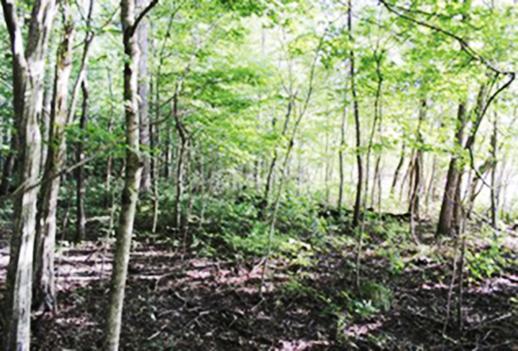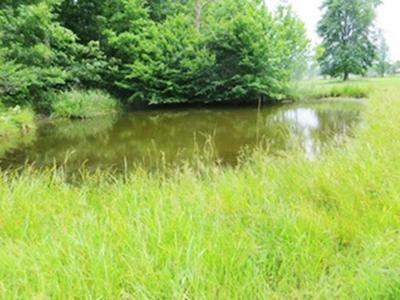Could Loretto’s Mission Extend to a Woodland Burial Place?
Posted on November 1, 2016, by Loretto Community
By Cecily Jones

Photo by Peg Jacobs
Could the desire of some Loretto Community members for a nature (“green”) burial in the Motherhouse woods develop into a new aspect of Loretto’s mission of reaching out in service to others? Very possibly, if the work of a sub-group of the Farm and Land Management Committee keeps evolving. This article is based on a conversation with the members of that group, Susan Classen, Peg Jacobs and Kathleen Vonderhaar, along with Maria Visse. The topic: a nature preserve cemetery at Loretto.
A bit of background may remind Interchange readers that interest in a natural burial (formaldehyde-free preparation of the body; a biodegradable coffin or container; perhaps only a shroud) has been high at the Motherhouse for at least six years, spurred on by presentations, films, discussions, information sessions and then specified wishes. A statement from Peg perhaps crystallizes the desire of many: “I’m very grateful to Earth for my life, so I want to give myself back to Earth, with thankfulness and with great hope for Earth’s future.”
Kathleen pointed out that interest in green burials has grown tremendously across the country. One figure to illustrate this: In 2006, the Green Burial Council approved only one provider of such interments; in 2014, it approved 340!
Green burials now may take place in the Motherhouse cemetery, but the group’s search for a special forested niche has led to wider considerations. Perhaps this space could become a nature preserve cemetery, a permanently protected preserve that also provides a natural environment for green burials. As such, it could offer others a serene setting for their final resting place as well as a peaceful environment for those who grieve the loss of a loved one.

Photo by Peg Jacobs
Such a site, Maria noted, is very counter-cultural in the face of all the resources poured into vaults and monuments and mausoleums that are the features of so many cemeteries. Gradually it could help change the way our culture approaches the topic of death.
“There seems to be a growing awareness among many that humans, just like every other life form, are part of the natural cycle of living and dying,” said Susan. The nature preserve cemetery could support and broaden that awareness. On the other hand, there is a resistance to recognizing the reality of death, part of the resistance to limits of any kind, apparent, for example, in how fossil fuel companies resist the finiteness of Earth’s resources. The nature preserve burial place could help lower the denial of the life-death cycle.
One aspect of the current death denial, pointed out by Peg and Maria, is the burgeoning of anti-aging services and products. Promoters, many of them doctors, seem to espouse the view that aging is a disease that technology and medicine can fix rather than the realistic view of aging and death as parts of a natural process.
The thought of a possible nature preserve may elicit reflection on Loretto’s “Land Ethic,” which stresses that our commitment to work for justice and act for peace includes caring for the land. Already that caring is evident in multiple ways with which Interchange readers are familiar. However, a new slant was suggested with Susan’s expression of “allowing the land to continue its mission.” Its ecosystem services include realities such as these: one acre of woods provides enough oxygen for 18 people per year, and one acre of grassland sequesters 15 tons of carbon. (On average, a car emits 5 tons of carbon yearly.) A nature preserve would continue offering the gifts of land’s mission … and of Loretto’s mission. Two years ago, the Farm and Land Management Committee identified its four mission priorities, one of which was to provide a peaceful and healing place. The nature preserve cemetery could be an extension of the healing space already offered at Loretto through the Infirmary and the two retreat centers, Knobs Haven and Cedars of Peace.
Hearing such a litany of reasons for establishing the nature preserve cemetery led to inquiries about next developments. Kathleen pointed out that the idea is in evolution, that the sub-committee is taking one step after another, meeting every two weeks to consult. Between times, they have done their homework and their footwork. Together with others on the full committee, they have examined suitable forest areas. Susan visited the Foxfield Nature Preserve Cemetery in Wilmot, Ohio, learning the importance of partnering with a land trust in the endeavor. The sub-group has continued its research and its reading. As Peg said, “We are essentially explorers!”
They are aware that a conservation easement would be needed for even a small parcel of land designated as a nature preserve cemetery. They will continue their consulting with experts on land trusts in Kentucky, interested and cooperative morticians, the Cemetery Planning Resource Alliance (which asserts that natural burials are a trend rather than a fad), the Green Burial Council, officials of Marion County. They also will explore the interfaith aspects that would be crucial elements in the design of such a cemetery.
And they will continue reporting to the wider Loretto Community about the intriguing possibility of a new phase of Loretto’s mission.
